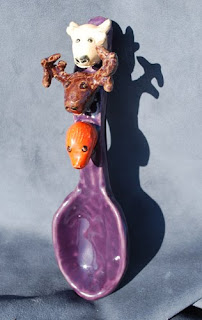 Like any teacher, I want to help my students as much as I can, however, if I thread one student's needle, I'll be stuck for the rest of the hour. The line will snake like a boa, encircling and ensnaring, constricting any hope I had of wandering freely among the industrious weavers in my art room and my students will limit their chances of gaining a skill. So, we practice the fold, pinch, jiggle method of needle threading. Needles with really big eyes, of course, make this process much easier.
Like any teacher, I want to help my students as much as I can, however, if I thread one student's needle, I'll be stuck for the rest of the hour. The line will snake like a boa, encircling and ensnaring, constricting any hope I had of wandering freely among the industrious weavers in my art room and my students will limit their chances of gaining a skill. So, we practice the fold, pinch, jiggle method of needle threading. Needles with really big eyes, of course, make this process much easier.Often I have students with various disabilities that make needle threading, cutting with scissors or other fine-motor, tool use, challenging. These students have so much to gain from fine-motor practice in the art classroom, but far too often, well-meaning adults step in and take away the opportunity to develop these hand skills. I sometimes have to ask a classroom aide to step back and allow the students to do the art project on their own. I try to explain that the process is more important than the end product. On the other hand, it is important to lend a hand or gently guide a hand if a student is becoming too frustrated. At these times, I am grateful for another pair of adult hands in the room.
Whether working with children in a classroom or raising your own children, deciding whether to give a helping hand or encourage the child to do it alone can be difficult. If you thread all their needles you may be stuck threading all their needles. However, if you let them do it alone, while there's the risk of a pricked finger, there's also the possibility of moving beyond perceived limitations.





I'm sure you already know this but just in case you don't... for my life skills students, or any student that is having trouble getting the yarn thorough the needle eye, I have them use a dental floss threader (the blue kind that you would use if you had braces or a retainer) to help them thread the needle.
ReplyDeleteSuch a great idea! Can you get this at a regular drugstore or target type store?
ReplyDelete